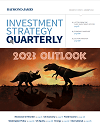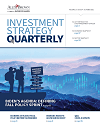Investors can anticipate lower returns for both bonds and stocks over the next several years vs. the last 10 years due to lower yield levels, starting valuations and economic conditions. Read more from Nick Lacy, CFA, Chief Portfolio Strategist for Asset Management Services.
U.S. equities have handsomely rewarded stock investors over the past 10 years, generating a 13.6% annualized total return as measured by the S&P 500 Index. This stands in stark contrast to returns on high-quality bonds over the same time period, which only returned approximately 3.6% per year as measured by the Bloomberg Barclays U.S. Aggregate Bond Index. However, the next 10 years will likely be very different than the last.
In order to make informed decisions when allocating assets, investors need to have a general idea of how each asset is expected to perform over a given time period. There are three broad asset classes that benefit from forecasting: stocks, bonds, and cash. Stocks tend to be the most difficult to forecast while bonds tend to be the least difficult.
Bonds
The best predictor of a return on a bond is the current yield on that bond, especially if it is a high-quality bond with a maturity matching the investor’s time horizon. For example, if an investor bought an investment-grade bond with yield to worst of 3%, the return over that time period would roughly equal 3% per year, all else being equal.
The yield of the Bloomberg Barclays U.S. Aggregate Bond Index has been a decent predictor of its future total returns. The current yield on U.S. investment-grade bonds is around 2.0%, which can be used to gauge return expectations over the next 5-10 years. It bears mentioning that this is substantially lower than the total returns of investment-grade bonds over the last 10-20 years. Current interest rates, not only in the U.S. but around the world, are much lower than they were before the financial crisis. With negative interest rates elsewhere around the world, this does not look like it will change any time soon.
Equities
Over time, equities should produce returns in line with earnings growth and dividends; however, the markets rarely do what they are supposed to do. The dividend yield on the U.S. equity market has hovered around 2% over the last 10 years, while earnings growth has been approximately 6.5% per year since 2010. Markets should have returned 8.5% (6.5% plus the 2% dividend yield). However, the market actually returned 13.6%, over 5.1% more per year. The fact that price-to-earnings (P/E) multiples expanded substantially from 2009 to 2019 helps explain the significant difference in returns over this time period.
What should investors expect going forward? Dividends are fairly constant and tend to average around 2%, while earnings or sales growth may vary. Research shows sales growth may be linked to economic growth and inflation, while earnings growth can be boosted by improving margins. What should we expect for economic growth over the next five years? Looking beyond 2020 and the impacts of COVID-19, consensus estimates indicate that U.S. GDP and inflation will grow at 2% each per year, which results in a 4% sales growth estimate. How much companies earn will depend on several factors, such as borrowing and profitability. If earnings growth is exactly the same as sales growth with a 2% dividend yield, investors should expect to see returns of 6% going forward (inflation plus GDP growth plus dividends). While returns could be boosted by an expansion in P/E multiples or additional borrowing beyond the levels seen thus far, this seems unlikely.
The moral of this story is that investors should expect to see both bonds and stocks return relatively less over the next several years compared to the past 10 years due to lower yield levels, starting valuations, and economic conditions.
Key takeaways
In order to make informed decisions when allocating assets, investors need to have a general idea of how each asset is expected to perform over a given time period. The three broad asset classes that benefit from forecasting are stocks, bonds and cash.
Current interest rates, not only in the U.S. but around the world, are much lower than they were before the financial crisis. With negative interest rates elsewhere around the world, this does not look like it will change any time soon.
Investors should expect to see both bonds and stocks return relatively less over the next several years compared to the past 10 years due to lower yield levels, starting valuations, and economic conditions.
Read the full April 2020
Investment Strategy Quarterly
Read the full April 2020
Investment Strategy Quarterly
All expressions of opinion reflect the judgment of Raymond James and are subject to change. Investing involves risk including the possible loss of principal. Past performance may not be indicative of future results. The performance noted does not include fees which would reduce an investor’s returns. Asset allocation does not guarantee a profit nor protect against loss. Dividends are not guaranteed and will fluctuate.
Markets & Investing Members of the Raymond James Investment Strategy Committee share their views on...
Markets & Investing Review the latest Weekly Headings by CIO Larry Adam. Key Takeaways ...
Technology & Innovation Learn about a few simple things you can do to protect your personal information...

